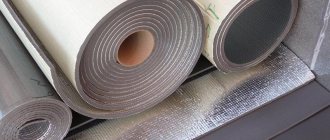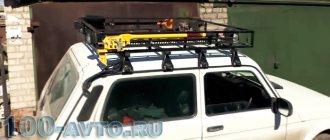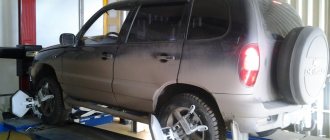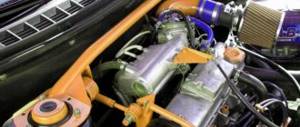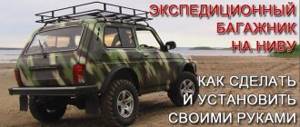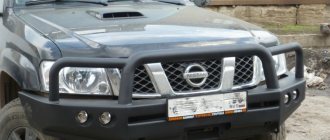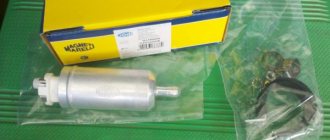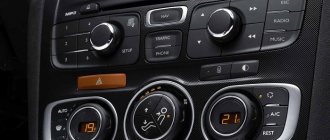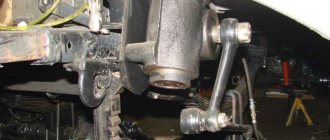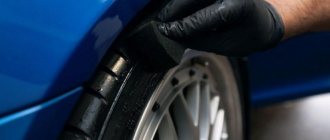The importance of maintaining the correct pressure in Chevrolet Niva tires is one of the most underestimated parameters by car owners. This is important because the pressure maintains a range of performance characteristics:
- car control stability;
- ride stability;
- braking distance within the design;
- specified trajectory of movement;
- uniform wear of the treadmill, due to which the service life of the tires is maintained at the proper level;
- integrity of the side surfaces;
- volumes of fuel consumption not higher than those specified in production.
The Niva manufacturer recommends that the pressure on both the front and rear axles reach 1.9 bar.
The recommendation applies to the sizes of 15-inch tubeless tires 205/70, 205/75 and 16-inch 215/65. In the case of off-road driving, factory recommendations allow the indicator to be reduced to one and a half bar. In some cases, car owners themselves increase the pressure to 2 or 2.2 bar for driving on the highway. The manufacturer indicates that pressure above two makes the ride harsher and less comfortable.
Review of the best summer and winter tires for the Chevrolet Niva
The most popular winter tires:
- Vredestein Wintrac Xtreme S - the tread consists of Velcro, which provides maximum traction on wet asphalt and loose snow. The maximum temperature of use is 25°C. The critical point is -35°. The average cost in online catalogs is from 8,500 rubles.
- Goodyear UltraGrip Performance Gen-1 - balanced price-quality ratio. The tire provides good traction on loose snow and ice at sub-zero temperatures. Average price from 7,000 rubles.
- Dunlop Winter Sport 5 is a soft compound rubber that is not susceptible to hardening when the temperature drops. The price of one tire is from 5,500 rubles.
- Pirelli Winter Sottozero 3 is a popular model among car enthusiasts in the CIS, including the Russian Federation. Good quality, technical specifications at an affordable price. The service life before replacement exceeds 60 - 70 thousand km. mileage The average price by region is from 5,000 rubles.
- Nokian WR D4 is an economical option for most car owners. High-quality grip, long service life, affordable price from 2900 rubles.
Summer tires for Chevrolet Niva:
- Goodyear Ecient is a high-quality tire at a premium price from a European manufacturer. The tire warms up within a few seconds, providing the widest possible contact patch with the road surface. Rubber guarantees grip, control, cornering, and a minimum percentage of skidding at medium and high speeds. Average price from 5000 rubles.
- Grip Performance is a budget option from a European brand. Better than standard tires in terms of technical characteristics, acceptable for use in urban conditions. Price from 5500 rubles.
- Hankook Ventus Prime3 K125 is also a budget model with a price starting from 6,000 rubles. Above average quality at an affordable price.
- Dunlop SP Sport MAXX RT2 is a tire with unidirectional tread, which ensures high handling and minimal vehicle roll when cornering, regardless of weather conditions and temperature conditions. Average cost from 5200 rubles.
- Dunlop SP Sport MAXX RT (size R16) - tires are similar to the previous ones, except that the tread pattern is asymmetrical. Price from 5100 rubles.
- Pirelli P7 Cinturato Blue - long service life is the main highlight of the rubber. The average service life exceeds 65,000 km before replacement. Average price from 5500 rubles.
Service station specialists strongly recommend changing tires strictly according to the seasons, and to a lesser extent using universal, all-season tires. The operating temperature range is several degrees lower than seasonal tires, resulting in reduced vehicle controllability.
Indices and tire sizes for Chevrolet Niva (4x4)
To choose the right tire you need to be able to read the indices and other symbols on the tires, namely:
- “T” - the maximum permitted speed of movement is not more than 195 km / h. “H” - up to 205 - 210 km/h. It is not recommended to exceed the speed range, as there is a high probability of shooting, cord deformation, and, as a result, an emergency;
- “Q” - load capacity index: from 85 to 490 kg;
- “ET” is the metal rim bead extension coefficient;
- “KM” - partial and full load index: no more than three passengers, cargo in the trunk up to 50 kg;
- “M+S” - full load - more than three people and over 50 kg in the trunk.
How the pressure sensor works, how to turn it off on a Chevrolet Niva
The main task of the controller is to monitor changes in air pressure in the tire and transmit data online to the electronic control unit. The latter compares the indicators with the programmed ones and informs the driver about a possible malfunction. Most often, this is a sound signal combined with light flickering.
Principle of operation
- A pressure measuring sensor is installed on the inside of the tire. This must be done with the wheel lowered.
- After activation, the controller measures the pressure every 3 seconds and sends the data to the ECU. Bluetooth technology is used as a means of communication.
- The electronic control unit analyzes the obtained indicators for each of the wheels and compares them with the specified parameters.
- The end result can be duplicated on a smartphone if a special application is installed on the latter.
How to disable pressure sensors
There is no such thing as deactivating a sensor for the reason that it is impossible, since the absence of equipment must be registered at the system level. In case of unauthorized deactivation of the controller, “Error” is displayed on the dashboard.
Some car owners practice physically dismantling controllers in a service station. Do not try to do this on your own, as unprofessional intervention does not guarantee full functionality of the electronic control unit.
Sensor sensitivity
- Sudden surges in pressure due to falling into a hole or road bump;
- Critical low/high pressure;
- Installation of rubber tires that are larger or smaller than the recommended standards;
- Installing a damaged tire;
- Uneven distribution of load on the axle, passengers in the vehicle interior;
- Systematic operation of the controller during lifting and lowering of the machine;
- Metal chains are installed on rubber tires.
Insufficient or excessive tire pressure threatens premature failure of the chassis, the tires themselves, excess fuel consumption, and most importantly, traffic safety. To test it, tapping with a shoe is not enough, as shown in old films. Visual inspection of clivus deformations is also not a sufficient assessment criterion, although it serves as a signal to doubt the correctness of pumping.
Instruments for checking the degree of pumping
For cars such as the Chevrolet Niva, maintaining this parameter is especially important. The center of gravity of this car is high, and the car cannot be called stable, especially during emergency maneuvers. It is impossible to measure the degree of air compression in a tire without special measuring instruments.
Pressure gauges are used for these purposes. They are divided into two categories that differ structurally:
- Mechanical pressure gauge. A device for measuring tire pressure, having a mechanical drive and a dial indicator. Has a significant degree of error, long service life, does not require a power source.
- Electronic pressure gauge. Electronic type device with a screen for displaying measurement data. It is powered by an internal power source; when used correctly, the error tends to zero.
Important: The error of devices of the first type is greater in winter than in summer due to temperature deformations of mechanical parts. In cold weather, it is recommended to use only to get to the garage or service station. The disadvantage of electronic pressure gauges is that the battery can run out at the most inopportune moment.
Frequency of measurements on Chevrolet Niva
In order not to endanger your life and the lives of others, you need to check the tire pressure before each trip, especially over long distances. The sequence of actions is as follows:
- We check the readings using a pressure gauge as indicated in the instructions for it. Tires should not be warm. The car must sit for three hours.
- We compare the readings with the data in the table of permissible tire pressure for the Niva 21214 car.
- After 30-40 minutes, we repeat the measurement, and if the readings become low, it means there is a puncture. Keeping the data at the same level indicates that you can leave.
Recommendation: After the end of the trip, another measurement is taken 2.5-3 hours later. This requirement is optional. However, when you drive the next day, you won't be surprised by a flat tire. All wheels are checked, including the spare.
What pressure should Niva tires have?
To always know what pressure gauge readings are considered normal, print out a table of acceptable readings and carry it in the glove compartment (if the metal plate on the car body is missing or has become unusable), and the pressure gauge in the trunk. In the cold season, the road surface is slippery and the tires are less elastic. Therefore, in winter, tire pressure should be lower than in summer. The permissible run-up is 0.2-0.3 bar.
Due to this, the area of the contact patch increases and the grip on the road increases. The standard pressure in Chevrolet Niva tires depends on the parameters of the ramp indicated on its sides. The table shows data for 205/75 R15, 205/70 R15 and 215/65 R16. These data are identical for the Chevrolet Niva 21214 and Niva 21213 models. In some emergency cases, it is possible to make the injection rate lower than recommended.
So, the pressure in the tires of a Niva Chevrolet in winter can be reduced to 1.2-1.5 atm if you get stuck in the snow. This will allow you to get out, but immediately after leaving on solid ground, the indicators must be brought to normal. The Chevrolet Niva, although an SUV, is not an all-terrain vehicle, and can get stuck not only in winter. What pressure to set depends on the type and degree of tread wear.
Tire pressure of Niva Chevrolet according to the passport
For cars such as the Chevrolet Niva, maintaining this parameter is especially important. The center of gravity of this car is high, and the car cannot be called stable, especially during emergency maneuvers. It is impossible to measure the degree of air compression in a tire without special measuring instruments.
Mechanical pressure gauge
Pressure gauges are used for these purposes. They are divided into two categories that differ structurally:
- Mechanical pressure gauge. A device for measuring tire pressure, having a mechanical drive and a dial indicator. Has a significant degree of error, long service life, does not require a power source.
- Electronic pressure gauge. Electronic type device with a screen for displaying measurement data. It is powered by an internal power source; when used correctly, the error tends to zero.
Important: The error of devices of the first type is greater in winter than in summer due to temperature deformations of mechanical parts. In cold weather, it is recommended to use only to get to the garage or service station. The disadvantage of electronic pressure gauges is that the battery can run out at the most inopportune moment.
Electronic pressure gauge for car tires
In order not to endanger your life and the lives of others, you need to check the tire pressure before each trip, especially over long distances. The sequence of actions is as follows:
- We check the readings using a pressure gauge as indicated in the instructions for it. Tires should not be warm. The car must sit for three hours.
- We compare the readings with the data in the table of permissible tire pressure for the Niva 21214 car.
- After 30-40 minutes, we repeat the measurement, and if the readings become low, it means there is a puncture. Keeping the data at the same level indicates that you can leave.
Recommendation: After the end of the trip, another measurement is taken 2.5-3 hours later. This requirement is optional. However, when you drive the next day, you won't be surprised by a flat tire. All wheels are checked, including the spare.
Tire Niva
To always know what pressure gauge readings are considered normal, print out a table of acceptable readings and carry it in the glove compartment (if the metal plate on the car body is missing or has become unusable), and the pressure gauge in the trunk. In the cold season, the road surface is slippery and the tires are less elastic. Therefore, in winter, tire pressure should be lower than in summer. The permissible run-up is 0.2-0.3 bar.
Due to this, the area of the contact patch increases and the grip on the road increases. The standard pressure in Chevrolet Niva tires depends on the parameters of the ramp indicated on its sides.
The table shows data for 205/75 R15, 205/70 R15 and 215/65 R16. These data are identical for the Chevrolet Niva 21214 and Niva 21213 models.
In some emergency cases, it is possible to make the injection rate lower than recommended.
So, the pressure in the tires of a Niva Chevrolet in winter can be reduced to 1.2-1.5 atm if you get stuck in the snow. This will allow you to get out, but immediately after leaving on solid ground, the indicators must be brought to normal. The Chevrolet Niva, although an SUV, is not an all-terrain vehicle, and can get stuck not only in winter. What pressure to set depends on the type and degree of tread wear.
If you do not adhere to the described operating requirements, the following will happen:
- Increased load on chassis parts will lead to premature wear and failure.
- Fuel consumption will increase due to the fact that the flat tire has a larger contact area. The protector, having opened, prevents movement. The engine will need to develop more power.
- The tires will wear out quickly. The reason for this is the increased contact patch with the road surface. By the way, lateral abrasion indicates that the tire is flat, and it is necessary to urgently take measurements and eliminate the cause.
- The risk of getting into an accident increases significantly, especially if you overinflate your tires in winter.
But if you monitor the amount of air in the slopes, the Chevrolet Niva will always remain a safe car with outstanding cross-country characteristics.
The importance of maintaining the correct pressure in Chevrolet Niva tires is one of the most underestimated parameters by car owners. This is important because the pressure maintains a range of performance characteristics:
- car control stability;
- ride stability;
- braking distance within the design;
- specified trajectory of movement;
- uniform wear of the treadmill, due to which the service life of the tires is maintained at the proper level;
- integrity of the side surfaces;
- volumes of fuel consumption not higher than those specified in production.
The Niva manufacturer recommends that the pressure on both the front and rear axles reach 1.9 bar. The recommendation applies to the sizes of 15-inch tubeless tires 205/70, 205/75 and 16-inch 215/65.
In the case of off-road driving, factory recommendations allow the indicator to be reduced to one and a half bar. In some cases, car owners themselves increase the pressure to 2 or 2.2 bar for driving on the highway. The manufacturer indicates that pressure above two makes the ride harsher and less comfortable.
Tire pressure is measured using special devices and at specified intervals. The main measuring device is a pressure gauge. There are two categories of this device:
- mechanical;
- electronic.
The first ones are distinguished by the fact that they have a mechanical drive in combination with a dial indicator. The disadvantage is the rather high level of error, which increases in the cold season. This is due to temperature deformation.
In connection with this, mechanical pressure gauges are used in the cold only as an aid until the opportunity to visit a service station arises.
But this disadvantage is offset by the long service life and the absence of the need for a power source.
The second category of devices is powered by a battery that is charged through a network connection. The main drawback is the ability of the battery to die at the most inopportune moment. Thanks to a more complex device, such a pressure gauge has minimal error.
The data is displayed on a screen similar to the display of other electronic devices.
Checking tire pressure before each long trip is a mandatory step to ensure the safe operation of the vehicle.
Do the necessary actions in a certain sequence:
- let the car sit for at least three hours;
- check that the tires are cold;
- connect the pressure gauge and take measurements as indicated in the instructions for it;
- check the result with the table of acceptable values;
- recheck the data after a half-hour pause.
Evidence of a puncture will be a decrease in readings between two measurements. The absence of any changes indicates that the situation is normal.
Experts recommend checking the pressure after driving. This must be done two and a half or three hours after stopping. Thanks to this additional measurement, you can eliminate the possibility of a puncture formed during the trip. It is necessary to measure data not only on the installed tires, but also on the one that is used as a spare.
Normal pressure indicators for tires installed on a Chevrolet Niva crossover depend on their size, weather conditions and type of road surface.
Service station experts recommend installing tires on a Chevrolet Niva strictly according to the season, thereby eliminating universal, all-season tires. When operating a machine in high positive or negative temperatures, the rubber composition changes its properties, thereby deteriorating the technical characteristics.
Before purchasing tires for a Chevrolet Niva yourself, get advice from specialists regarding the compatibility of tires with your car model.
The adhesion spot in winter should be larger than in summer. That is why the tire pressure should be reduced. The larger the grip area, the less likely it is to have an accident on a slippery road. For the accuracy of the indicators, it is necessary to take these indicators correctly. This is done as follows:
- First you need to check that the tires are not warmed up.
- Three hours before taking measurements, you should not use the car for its intended purpose.
- Measurements must be taken on all four wheels of the vehicle.
Only if the correct conditions are met can we assume that the tire pressure in a Chevrolet Niva is determined correctly. Of course, all owners of this brand are interested in the exact air coefficient in their tires. You need to know that the Chevrolet Niva with different tires has excellent measurements, namely:
- A Chevrolet Niva with 205/75 R15 wheels has a pressure in the front wheels of 2.1/30 atm./psi. The rear tires should have the same data;
- a model with tire size 215/65 R16 has rear performance of 2.2-31 atm/psi and front performance of 2.2/31.
A pressure gauge is used to measure tire pressure.
The dial pressure gauge is most often used, as it is the most reliable and cheapest. It works on the basis of a special spring. The same spring is the “Achilles heel” of the pressure gauge; if the device is hit or dropped, it can break.
A mechanical pressure gauge is more reliable. It is based on a cylindrical spring. However, this pressure gauge shows the greatest measurement errors.
An electronic pressure gauge has the greatest accuracy. True, very cheap devices lack this quality. Like any electronics, it is less reliable compared to its mechanical counterparts.
Often the driver remembers the tire pressure only 2 times a year - when changing tires at a tire shop before the next summer or winter season.
However, the wheel is not a completely sealed device and over time, depending on the degree of wear of the rubber, air may escape. Ideally, you should check the amount of air before each trip. But the most optimal control mode would be to check once every 2-3 weeks and before long trips.
| Tire type | Front, atm | Rear, atm |
| 205/70 R15 | 2.1 | 2.1 |
| 205/75 R15 | 2.1 | 2.1 |
| 215/65 R16 | 2.2 | 2.2 |
Consequence of violation of regulatory pressure Niva 21213
If you do not adhere to the described operating requirements, the following will happen:
- Increased load on chassis parts will lead to premature wear and failure.
- Fuel consumption will increase due to the fact that the flat tire has a larger contact area. The protector, having opened, prevents movement. The engine will need to develop more power.
- The tires will wear out quickly. The reason for this is the increased contact patch with the road surface. By the way, lateral abrasion indicates that the tire is flat, and it is necessary to urgently take measurements and eliminate the cause.
- The risk of getting into an accident increases significantly, especially if you overinflate your tires in winter.
But if you monitor the amount of air in the slopes, the Chevrolet Niva will always remain a safe car with outstanding cross-country characteristics.
Every car owner knows that the air in tires must be at a certain pressure.
The pressure standard is determined by the manufacturer. Deviation from which significantly affects the quality and safety of movement in a car.
Consequences of incorrect paging
| Disc mounting diameter, inches | Drive dimensions in inches | Tire size | |
| L, LG, GL | 15 | 6Jx15 | 205/75R15 205/70R15 |
| GLC, LE, LE | 16 | 6.5Jx16 | 215/65R16 |
Measuring methods
If the tire is flat or the standard is lower, more fuel will be consumed, and this also leads to wear on the tire itself, which can lead to undesirable consequences, for example, the stability of the car may deteriorate, or there will be rapid wear of the tread in the center of the tire, increasing the chance of that the tire will simply burst, that movement in time can provoke an accident.
You should also pay attention to the pressure when transporting heavy loads; it needs to be increased to compensate for the load on them. You can find out what it should be, guided by a special manual, or from the table above, and on most Niva cars this information is on the driver’s door.
Your safety on the roads while driving a car directly depends on how correct it is. Therefore, such basic rules as regular monitoring should not be neglected.
Why is it necessary to control?
Reduced or increased air content leads to a change in the contact surface of the tires with the road surface. This leads to various consequences.
For high blood pressure:
At low pressure:
- increased contact area with asphalt
- fuel consumption increases
- the tread wears out faster and unevenly, more at the edges
- car control deteriorates
- decreased stability when turning and changing lanes at high speed
- the chance of tire and rim damage increases when a wheel falls into a hole
The greatest danger comes from different pressures in all wheels. While driving, the vehicle “steers” towards the wheel with the lowest value.
Measuring devices
A pressure gauge is used to measure tire pressure.
There are three types of pressure gauges:
- mechanical;
- switches;
- electronic.
The dial pressure gauge is most often used, as it is the most reliable and cheapest. It works on the basis of a special spring. The same spring is the “Achilles heel” of the pressure gauge; if the device is hit or dropped, it can break.
A mechanical pressure gauge is more reliable. It is based on a cylindrical spring. However, this pressure gauge shows the greatest measurement errors.
An electronic pressure gauge has the greatest accuracy. True, very cheap devices lack this quality. Like any electronics, it is less reliable compared to its mechanical counterparts.
Important
. The check is carried out on cold wheels. This means that the machine must be left at rest for at least 3 hours.
Check frequency
Often the driver remembers the tire pressure only 2 times a year - when changing tires at a tire shop before the next summer or winter season.
However, the wheel is not a completely sealed device and over time, depending on the degree of wear of the rubber, air may escape. Ideally, you should check the amount of air before each trip. But the most optimal control mode would be to check once every 2-3 weeks and before long trips.
In spring and autumn, when sudden temperature changes are possible, it is better to check more often. When the temperature changes by 10˚C, the air pressure changes by at least 0.1 bar.
Table of standards for various tires
| Tire type | Front, atm | Rear, atm |
| 205/70 R15 | 2.1 | 2.1 |
| 205/75 R15 | 2.1 | 2.1 |
| 215/65 R16 | 2.2 | 2.2 |
Attention!
The pressure in the rear tires should be approximately 0.3 - 0.5 bar higher if you plan to carry a heavy load.
In winter, you can slightly reduce the amount of air to increase the tire contact area with the road.
So, dear car enthusiasts, do not forget to regularly check the tire pressure, because the safety of you and your loved ones depends on it.
Relieving pressure correctly
In order for the readings to be accurate, you need to remove the pressure correctly. This should be done this way:
- tires must be unheated;
- for the last 3 hours before measurement, the car should be at rest or drive no more than 1.5 kilometers;
- Measurements must be taken on all four wheels and the spare wheel.
Only in this case can the readings from the pressure gauge be considered correct.
Table of values for the required tire pressure level for the Chevrolet Niva:
The pressure standards for Niva wheels 2121 or 21214 must be indicated on a special metal plate. As a rule, it is attached to the door on the driver's seat side. If for some reason there is none, you can look at the data online. But in this case, it is better to take into account the readings only approximately.
You should also pay attention to the fact that the amount of air in the rear tires should be about 0.3-0.5 bar more. This is due to the fact that the load on the rear axle of the wheel is always greater than on the front.
Checking car tire pressure
Interesting video about the effect of tire pressure on cross-country ability:
Keeping your car tires within the correct pressure range can help noticeably improve fuel economy, reduce CO2 emissions and prevent premature tire wear and unnecessary tire purchases. Regular monitoring of tire pressure is also very important to ensure safe driving on the roads.
| Automobile model | Years of production | Tire size | Front tire pressure (atm./psi) | Rear tire pressure (atm./psi) |
Chevrolet Cobalt | 2013-2014 | 195/65 R15 | 2,4/34 | 2,4/35 |
| Chevrolet Cobalt | 2013-2014 | 185/75 R14 | 2,5/35 | 2,5/35 |
Chevrolet Niva | 2004-2014 | 205/75 R15 | 2,1/30 | 2,1/30 |
| Chevrolet Niva | 2004-2014 | 205/70 R15 | 2,1/30 | 2,1/30 |
| Chevrolet Niva | 2004-2014 | 215/65 R16 | 2,2/31 | 2,2/31 |
| Chevrolet Camaro - front tires | 2009-2014 | 245/45 R20 | 2,5/35 | 2,5/35 |
| Chevrolet Camaro - rear tires | 2009-2014 | 275/40 R20 | 2,5/35 | 2,5/35 |
| Chevrolet Matiz | 1998-2005 | 155/65 R13 | 1,9/27 | 1,9/27 |
| Chevrolet Matiz | 1998-2005 | 175/60 R13 | 1,9/27 | 1,9/27 |
| Chevrolet Matiz | 2005-2009 | 145/70 R13 | 2,1/30 | 2,1/30 |
| Chevrolet Matiz | 2005-2009 | 155/65 R13 | 2,1/30 | 2,1/30 |
Chevrolet Spark | 2010-2014 | 155/70 R14 | 2,2/32 | 2,2/32 |
| Chevrolet Spark | 2010-2014 | 165/60 R15 | 2,2/32 | 2,2/32 |
| Chevrolet Kalos | 2004-2008 | 155/80 R13 | 2,1/30 | 2,1/30 |
| Chevrolet Kalos | 2004-2008 | 175/70 R13 | 2,1/30 | 2,1/30 |
Chevrolet Aveo | 2008-2011 | 155/80 R13 | 2,1/30 | 2,1/30 |
| Chevrolet Aveo | 2008-2011 | 185/60 R14 | 2,1/30 | 2,1/30 |
| Chevrolet Aveo | 2011-2014 | 195/65 R15 | 2,5/35 | 2,5/35 |
| Chevrolet Aveo | 2011-2014 | 205/55 R16 | 2,5/35 | 2,5/35 |
Chevrolet Lanos | 1997-2003 | 175/70 R13 | 2,2/32 | 2,2/32 |
| Chevrolet Lanos | 1997-2003 | 185/60 R14 | 2,2/32 | 2,2/32 |
| Chevrolet Nubira | 1997-2003 | 185/65 R14 | 2,1/30 | 2,0/29 |
| Chevrolet Nubira | 1997-2003 | 195/55 R15 | 2,1/30 | 2,1/30 |
| Chevrolet Nubira/Lacetti Placecard | 2003-2011 | 195/55 R15 | 2,1/30 | 2,1/30 |
Chevrolet Cruze | 2009-2013 | 205/60 R16 | 2,2/32 | 2,2/32 |
| Chevrolet Cruze | 2009-2013 | 215/55 R17 | 2,2/32 | 2,2/32 |
| Chevrolet Volt | 2012-2014 | 215/55 R17 | 2,5/35 | 2,5/35 |
| Chevrolet Leganza | 1997-2003 | 205/60 R15 | 2,0/29 | 2,0/29 |
| Chevrolet Evanda | 2004-2007 | 195/70 R14 | 2,1/30 | 2,1/30 |
| Chevrolet Evanda | 2004-2007 | 205/65 R15 | 2,3/33 | 2,1/30 |
Chevrolet Epica | 2006-2011 | 205/65 R15 | 2,0/29 | 2,0/29 |
| Chevrolet Epica | 2006-2011 | 205/60 R16 | 2,0/29 | 2,0/29 |
| Chevrolet Tacuma/Rezzo | 2000-2009 | 185/70 R14 | 2,2/32 | 2,2/32 |
| Chevrolet Tacuma/Rezzo | 2000-2009 | 195/60 R15 | 2,2/32 | 2,2/32 |
Chevrolet Orlando | 2011-2014 | 215/60 R16 | 2,5/35 | 2,5/35 |
| Chevrolet Orlando | 2011-2014 | 225/50 R17 | 2,5/35 | 2,5/35 |
| Chevrolet Trax | 2013-2014 | 205/70 R16 | 2,1/30 | 2,1/30 |
| Chevrolet Trax | 2013-2014 | 215/55 R18 | 2,1/30 | 2,1/30 |
| Chevrolet Rexton | 2002-2004 | 235/70 R16 | 2,1/30 | 2,1/30 |
| Chevrolet Rexton | 2002-2004 | 255/65 R16 | 2,1/30 | 2,1/30 |
Chevrolet Captiva | 2007-2011 | 215/70 R16 | 2,1/30 | 2,1/30 |
| Chevrolet Captiva | 2007-2011 | 235/55 R18 | 2,1/30 | 2,1/30 |
| Chevrolet Captiva | 2011-2014 | 215/70 R16 | 2,5/35 | 2,5/35 |
| Chevrolet Captiva | 2011-2014 | 235/55 R18 | 2,5/35 | 2,5/35 |
| Chevrolet Tahoe | 1999— | 265/70 R16 | 2,2/32 | 2,2/32 |
Your car's manual will best tell you what pressure should be in the tires of your Chevrolet. Every two weeks and before long trips, be sure to check the pressure of your car tires (including the spare tire) to make sure that they are not under low or over pressure, and if necessary, inflate the wheels. This is best done at a tire shop.
If tire pressure is too low, you will use more fuel and will also cause increased wear on the edges of your tires, which will significantly shorten their life. But overinflated car tires can lead to unpredictable consequences, worsening the stability of the car on the road and accelerating the wear of the tread in the center of the tire.
Also adjust the pressure in your Chevrolet tires when transporting heavy loads. If you are carrying a heavy load, you will need to increase the air pressure in your car tires to compensate for the load on them. You can find the correct heavy-duty tire pressure in your Chevrolet manual, and some vehicles will also display pressure information on the driver's door.
One of the important aspects of a safe ride is the correct tire pressure. Car enthusiasts often do not pay special attention to such a small thing as pressure. But this is far from a trifle, and with an inappropriate wheel inflation index, not only the car, but also the passengers can suffer.
Sometimes even experienced drivers do not know exactly how many atmospheres should be in the tires of their own car. Each car has its own indicators regarding the optimal tire pressure. And they may differ on the front and rear wheels. This is explained by the fact that when the car is loaded, more load is placed on the rear tires. Therefore, the pressure in them is usually higher than in the front ones.
Inflated wheel
Each vehicle undergoes many tests before reaching auto stores. And among them there are tests for optimal tire pressure. Each individual car has its own standards regarding the amount of atmospheres in the wheel. And they are indicated by the manufacturer on the gas tank hatch or on the driver's door. It clearly states the optimal indicators for minimum and maximum vehicle load. It is these parameters that vehicle owners need to adhere to.
Those drivers who are fans of Niva should pay special attention to pressure indicators.
This is because the car has a high center of gravity. It is difficult to control in an emergency situation, such as a sharp turn, as it is not very stable. Therefore, it is necessary to monitor and check the amount of atmosphere in a tire once a week. For such measurements there are special pressure gauges, which are:
- mechanical;
- electronic;
- rack and pinion
On a note.
Mechanical models are considered more durable, but often have measurement errors.
They don't need a power source, which is another plus. Electronic devices have virtually no errors, but are dependent on batteries that can run out at the wrong time. Rack and pinion pressure gauges are considered very inconvenient to use, but they do not allow for inaccuracies. Few people use them because they are very fragile.
The pressure in the Chevrolet Niva wheels on the front and rear axles is no different. For example, the optimal indicators correspond to 2.1 atmospheres, and at maximum load they increase to 3.0. However, these standards may vary depending on the radius of the wheel. In winter, you can reduce the pressure slightly, by about 0.2 bar. This helps the hard rubber handle the road and increase the contact patch area. In summer, atmospheric indicators should be kept within the recommendations
Consequences of incorrect tire pressure
Neglecting the pressure in the wheels of a Chevrolet Niva can lead to a number of negative consequences for both the car itself and its owner. The most significant of them:
- premature wear of the chassis with inevitable failure of one or another of its parts - caused by increased load;
- if the pressure is too low, fuel consumption increases, which directly depends on the area of contact of the rubber with the road;
- an excessively widened tread prevents the car from moving normally;
- to overcome obstacles, the motor is forced to develop more power;
- if the pressure is too high, then due to poor traction the risk of getting into an accident increases;
- lateral tire wear due to flat tires;
- accelerated tire wear on hard surfaces is the result of low pressure.
Timely adjustment of the pressure level, in accordance with the recommendations specified in this article, will help to avoid all these problems.
The tire pressure of any car is not just the key to a comfortable ride. Maintaining the correct level of air in the tires of any vehicle is, first of all, the safety of the driver and passengers on the road.
Also, incorrect tire pressure can cause problems in the operation of the entire chassis and wheelbase of the vehicle. Therefore, this indicator should be monitored regularly. Next, we will consider how this should be done on a Chevrolet Niva car, and what the consequences of incorrect indicators are.
Car tire pressure monitoring
Chevrolet Spark tire pressure indicators
Many people consider the Chevrolet Spark to be a toy car, but this is not at all true. It doesn’t have much power, but it can quickly dodge at a traffic light. The recommended tire size for it is from R13 to R15. In summer, you need to inflate all wheels to 2.2 Bar, and in winter to 2.1 Bar. If you do not adhere to such indicators, then if the car is under-inflated, it will be difficult to control, and it will skid when turning, especially in winter.
When the atmospheric indicators are different in all tires, then this is the worst thing that can happen to the wheels.
In such a situation, underinflated tires will literally drive sideways, and fuel consumption will increase significantly. When the number of atmospheres does not match the recommended standards, this can lead to:
- tread wear;
- premature tire wear;
- deterioration of controllability;
- failure of the car's chassis;
- excessive fuel consumption.
So it’s better to adhere to these standards than to spend money on new spare parts and tires.
It is necessary to check the pressure only when the tires are cold, otherwise the pressure gauge will show an incorrect result.
The machine must be at rest for at least three hours for the pressure readings to become clear. As the tire heats up, the volume of air inside it also increases, so for accurate readings you need to take measurements on cold tires.
What tires can be installed instead of the factory ones?
The reasons for installing tires with other sizes may be different, for example, the driver wants to increase the speed of the car, or increase its maneuverability and weight load. It all depends on the conditions in which you will operate the car. An option to replace factory tires in the summer can be 215/75R15 tires, and for a wheel with a diameter of R16 in the winter, 215/65R16.
Usually, after indicating the size, the tire is marked with a load index and a speed index. The speed index is indicated by Latin letters, the load index is indicated by a number. For a Chevrolet Niva, you need to install a tire with the Q index, which means the maximum safe speed on such tires is no more than 160 kg. There is no point in installing a tire with a high speed index, since the car engine simply will not support it.
When selecting a tire, you must strictly adhere to the seat diameter. You cannot put an R16 tire on an R15 rim, or vice versa, an R15 tire on an R16 rim. In the first case, the rubber will simply dangle on the disk, and in the second case, it may burst during installation or while driving.
Tire pressure in Chevrolet Aveo
In the case of a Chevrolet Aveo, tire pressure varies significantly depending on the tire size. So, for example, in wheels R13-R14 the number of atmospheres should be 2.1 Bar. And with increased load it increases to 3.0 Bar. But tires of size R15-R16 require an increase in indicators to 2.5 Bar at minimum load, and up to 3.5 Bar at maximum.
In the summer, hot weather causes the air to heat up and tire pressure to increase slightly. Therefore, you can underinflate the wheels by about 0.2 Bar. Before every long trip, it is worth checking the indicators in all four wheels and in the spare tire.
If you don’t want to fool your head with constant measurements, then you can simply buy a pressure control system that will do everything automatically.
This device measures both the pressure and temperature of the air inside the tire. All results are displayed on the electronic panel. And if the sensor notices a violation of the amount of atmospheres in any tire, the system notifies the owner about this with a sound or light signal.
If you don’t want to spend a lot of money on such a system, you can purchase mechanical controllers that screw onto a nipple. As the pressure drops, the color of the cap changes. This device does not notify of violations of standards. Only visual control is possible behind it.
Pressure meter
How to measure tire pressure correctly
Tire Niva
Tire pressure on a Chevrolet Niva can only be determined using pressure gauges. There are two types of such devices:
- mechanical (switch);
- electric.
Electric pressure gauge for cars
I was passing by and couldn’t resist watching a video about how you can dig or how you can not dig, even if you’re indescribable.
Tire pressure sensors TPMS.
It is also necessary to emphasize that in winter the tire pressure level can only be measured more or less accurately only with an electric pressure gauge.
It is impossible to determine the amount of air in tires without special instruments. Outwardly, it turns out to notice only some deformations, the cause of which was incorrect pressure. As a result, some depression may appear on the rubber itself and the tread pattern may change.
You can measure tire pressure on a Chevrolet Niva only using pressure gauges. There are two types of such devices:
- mechanical (switch);
- electronic.
Incorrect tire performance can lead to disruption of the entire chassis, which will subsequently be costly and problematic to replace. That is why it is important to know what pressure is in the wheels and adjust it if necessary. Note that this problem cannot be solved without special instruments. Outwardly, you can only notice deformations, if any, which are caused by incorrect pressure. So, you can measure this indicator on a Chevrolet Niva car using a pressure gauge.
Correct pressure in a Chevrolet Cruze
Cruze cars may have tires of size 15, 16, or 17. The optimal pressure should be 2.2 bar. These parameters apply to both the front and rear axle wheels. The table on the car body indicates that the minimum fuel consumption is achieved at 2.7 Bar. On the one hand, this is good, but on the other hand, there will be an increased load on the suspension and the middle part of the tread, which will wear out intensively.
On a note.
These parameters are suitable for fast movement on the highway, but for ordinary city roads it is better to stick to 2.2 bar. Therefore, it is not worth maintaining high blood pressure unnecessarily for a long time. This may still be justified when the machine is heavily loaded. Then increasing the number of atmospheres is simply necessary, since the tires are under heavy load.
Consequences of incorrect pressure
In addition, if the pressure is incorrect, the chassis and wheelbase of the Niva 2121 or 21214 are destroyed. The following negative factors may also arise:
- fuel consumption will increase significantly (on average by 1.5-2 liters);
- tires will become deformed;
- There will be a possibility that the tire will burst while driving, which could lead to an accident.
All these negative factors can be avoided if you timely measure the pressure in Niva 21214 or 2121. By the way, this applies to any vehicle.
Your safety on the road while driving depends on the pressure in the tires of your Niva 2121. Therefore, you should not neglect such checks - they need to be carried out regularly (on your own or at a service station).
In addition, in addition to safety while driving, if tire pressure standards are not observed, the vehicle's chassis and wheelbase wear out much faster.
The importance of maintaining the correct pressure in Chevrolet Niva tires is one of the most underestimated parameters by car owners. This is important because the pressure maintains a range of performance characteristics:
- car control stability;
- ride stability;
- braking distance within the design;
- specified trajectory of movement;
- uniform wear of the treadmill, due to which the service life of the tires is maintained at the proper level;
- integrity of the side surfaces;
- volumes of fuel consumption not higher than those specified in production.
In the case of off-road driving, factory recommendations allow the indicator to be reduced to one and a half bar. In some cases, car owners themselves increase the pressure to 2 or 2.2 bar for driving on the highway. The manufacturer indicates that pressure above two makes the ride harsher and less comfortable.
Pressure indicators "Lacetti" Hatchback
All experienced motorists recommend following the manufacturer's recommendations regarding optimal tire pressure. If the wheels on the car are factory, then there is no need to deviate from the provided standards. But if the car was refitted with other tires of a different size, then the indicators may vary slightly. It all depends on the recommendations of the tire manufacturers.
If no more than four people travel in a car, then the number of atmospheres should be 2.1 bar. And when the car is fully loaded, you need to pump it up to 2.4 Bar. Such brands of cars are often produced with a built-in pressure control system. Therefore, it is much easier to follow the standards, since all measurements are taken automatically.
Consequences of incorrect tire pressure
Chevrolet Orlando tire pressure
This brand of car has a fairly large size and weight, so the atmosphere indicators in tires are higher than those of the previous models under consideration. The manufacturer recommends maintaining a value of 2.4 Bar in all four wheels. And when the load increases, raise it to 2.7 Bar.
But many car enthusiasts complain that when the wheels are inflated this way, the car drives harshly and a rattling sound is heard inside the cabin.
Therefore, on forums you can often find advice from drivers who recommend pumping the wheels to just 2.0 bar. With such indicators, the car drives smoother and there is no discomfort while driving. Convenience may be higher, but tire wear still increases. And fuel consumption will increase slightly.
It is necessary to monitor the pressure in your tires regularly. Failure to comply with the standards specified by the car manufacturer can affect not only the wear of car parts, but also the safety of the driver and his passengers. You need to be especially careful when choosing a pressure gauge. It is better to purchase a more expensive option with a high accuracy class than to later suffer from incorrect readings from a cheap model.
What pressure should be set in tires
Setting normal tire pressure will reduce vehicle maintenance costs by reducing fuel consumption and tire wear. In addition, the driving safety and maneuverability of the vehicle depend on the tire pressure.
The tire pressure for cars with an R 15 rim should be 1.9 kg/cm², and for a R16 rim, slightly higher than 2.0 kg/cm². On Chevrolet Niva cars with 4x4 axles in off-road conditions, as well as in winter when driving on loose snow, you can reduce the pressure to 1.2-1.5 kg/cm². On a flat, high-speed highway, many increase tire pressure by 0.1-0.2 kg/², although this leads to stiffer car suspension and reduces ride comfort.
Using a vehicle with tire pressures other than normal can lead to the following consequences:
- Increased wear on the vehicle's suspension and chassis parts.
- Driving on a flat tire will increase gas mileage because the tire has more contact with the road surface and the engine needs to develop more power. Due to this, tire wear will increase.
- With high tire pressure, contact with the road decreases and driving becomes unsafe, especially in winter.
